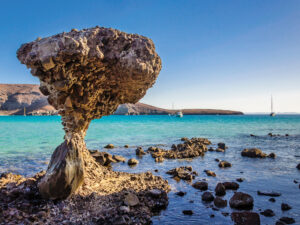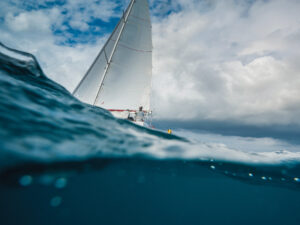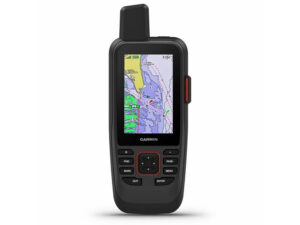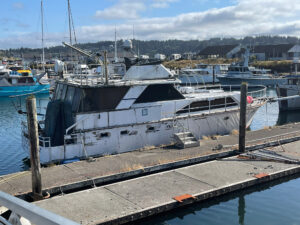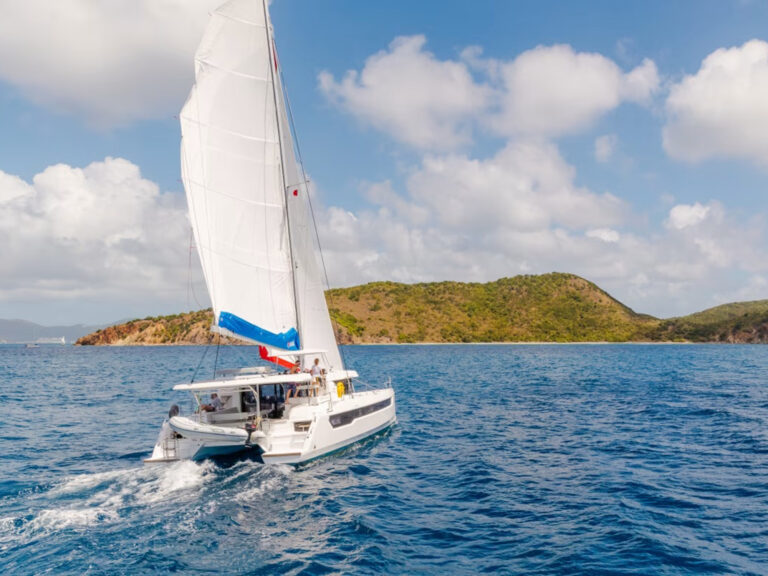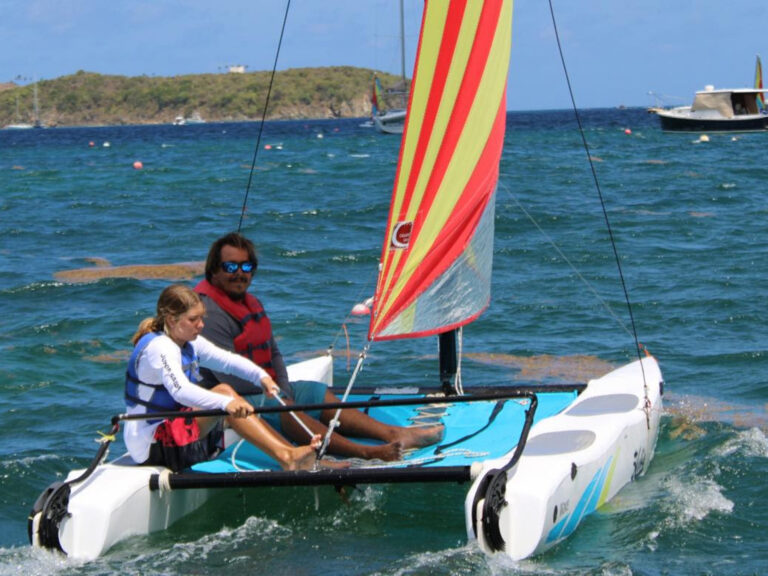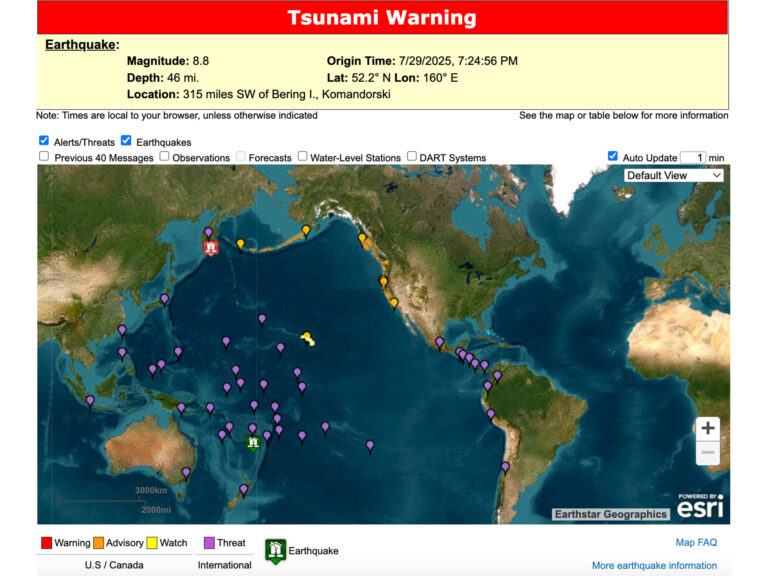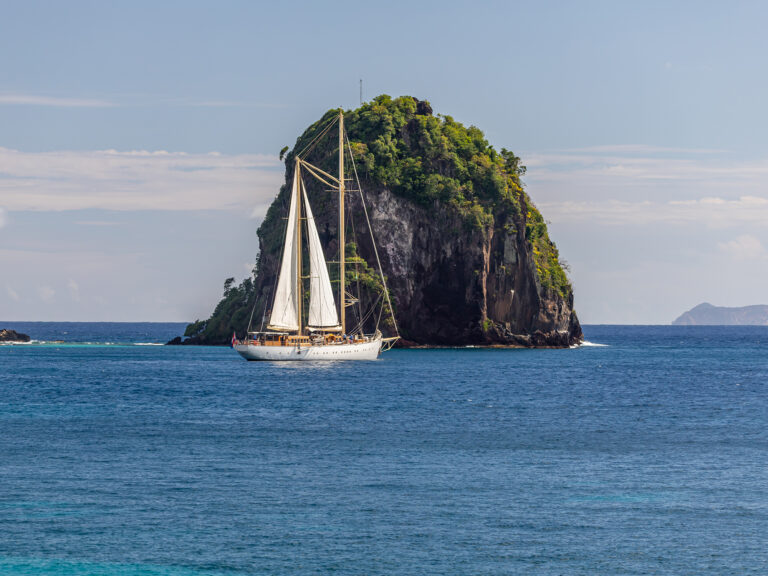
Michael FitzRoy
My plane touched down in Santiago, in Cape Verde, in the middle of the night. Hours earlier, I’d taken flight from frantic Charles de Gaulle Airport in Paris and now emerged into a humid, pulsing, Conradian darkness. A taxi drove me to the extremity of a decrepit industrial container port where I found, as if transported by time machine, the eye-popping, three-masted square-rigger Stad Amsterdam moored at the end of a concrete quay.
A young Dutch crewman met me at the gangplank and showed me below to my cabin. A man was sleeping in the bunk opposite mine, but the light was on, and he woke up immediately. I thought I recognized him but couldn’t quite place him.
“Oh, hi there. Michael FitzRoy,” he said, sitting up and sticking out his hand. “I loved your book about the old boy,” he continued, referring to Evolution’s Captain, my story about the skipper of HMS Beagle, a fanatical Christian called Royal Navy Lieutenant Robert FitzRoy, and his complicated friendship with Charles Darwin, Beagle‘s probing young naturalist.
I shook his hand. “So you’re his . . .”
“Great-great grandson.”
Five months earlier, I’d received an email from Henk Bas, a producer for the Dutch equivalent of PBS. To commemorate the 200th year since Darwin’s birth and the 150th anniversary of his publication of On the Origin of Species, the network was preparing a 41-part television documentary series on Darwin’s Beagle voyage.
The Dutch filmmakers, Bas continued, had chartered Stad Amsterdam and were sending her around the world along the route sailed by HMS Beagle on her historic five-year voyage that commenced in 1831. Because I was the author of Evolution’s Captain, Bas invited me to sail the transatlantic leg of the voyage from Cape Verde to Salvador, in Brazil; on this trip, the series would introduce and concentrate on FitzRoy.

| |Chartered by a Dutch public-television network, the 256-foot Stad Amsterdam was bound for distant shores to recreate the historic voyage of the HMS Beagle.|
Saint Jago, as the city was then named, marked an important moment in Charles Darwin’s career. When the Beagle anchored there on January 16, 1831, three weeks out of England, Darwin, who’d been seasick the entire time, dashed ashore and “feasted upon oranges.” Then he strolled beyond the shantytown port into a deep, unspoiled valley. It was his first glimpse of the world beyond Britain. He’d read the floridly detailed books written by other voyagers to exotic lands, notably the works of Alexander von Humboldt. Darwin now witnessed such a place with his own eyes: “Here I first saw the glory of tropical vegetation,” he wrote in his diary. “It was like giving to a blind man eyes.” And it was here, on this first stop of the Beagle‘s expedition, that it first occurred to Darwin—a 22-year-old frat boy fresh out of Cambridge—that he too might someday write a book about his travels.
Michael FitzRoy looked astonishingly like his famous ancestor: His features, the shape of his head and face, and his receding hairline were identical. Like the captain, whom Darwin initially found so charismatic, Michael was immensely charming and, I was to learn, funny. There, fortunately, the genetic inheritance stopped. Michael, a stock broker and art dealer, showed no signs of the captain’s bi-polar demons that led him to end his life by slashing his throat with a razor not long after the publication of his former shipmate’s book, On the Origin of Species.
At breakfast in “the long room,” the vast open saloon/dining room aft, I met another guest of the TV crew, Sir James Barlow, a mechanical engineer for Bell Canada and a compact, tidy man who bore no resemblance to his tall, great-great grandfather, Charles Darwin. An ambassador for the Galápagos Conservation Trust, James was a keen ornithologist who habitually wore binoculars around his neck.
After breakfast, we put to sea. A magnificent and utterly authentic-looking clipper ship, the Amsterdam was no Beagle. I’d already done some gawping on its website. Launched in 2000, built of steel and smothered in teak, the 256-footer displaces 1,038 metric tons (over 2 million pounds) and is powered by a 1,004-horsepower diesel. She has 14 air-conditioned double or quadruple cabins amidships with en suite bathrooms, for guests. A crew of 30 is housed forward. In 40 years of hanging around boats in Europe and the United States, including a job that required me to go around the world scouting for square-rigged ships for an ill-fated pirate movie, I’d never encountered such a vessel.
The Amsterdam is a close replica of a 19th-century tea-clipper design: She resembles the famed Cutty Sark, berthed at Greenwich, England, but she’s larger. Her underbody incorporates some evolutionary naval architecture, but in rig and features, in warp and weft, she’s absolutely authentic. Every wire aboard is wormed, parceled, and served in first-class marlinspike fashion. She needs every member of her crew to climb aloft on ratlines to shake out or stow sail. She’s not a cruise ship; not a Maine coasting schooner; not an austerely functional naval training vessel. And she’s not luxurious. But by God, she’s yar: Bristol fashion in all her parts.

| |The descendants (left) of FitzRoy (blue shirt) and Darwin (with binoculars) take a break in the filming.|
Once we were under way, the wind was light, from the north, and the swell slight. Outside the port breakwater, the crew—men and women, mostly in their early 20s, from Holland and Britain, with one American woman—swarmed up the shrouds and out along the yards, clipped on their harnesses, and made sail. The ship heeled with stately solidity, and we bore off to the south-southwest, on a heading beyond the equator for Brazil.
I was itching to go aloft and feel the heave of the ship; I wondered if they’d let me or if liability issues would forbid it. “Yes, just get harness instruction with the crew first,” said Captain Richard Slootweg easily. “And then don’t fall, please,” he grinned. A young crewman took Michael FitzRoy and me forward to show us where the harnesses were stowed. We asked Sir James if he wanted to join us. “No, thanks,” he said, giggling the way some people do when you suggest bungee jumping or hang-gliding. “I’ll watch you,” he said, binoculars at hand.
Correctly harnessed, we climbed the ratlines unattached—not clipping on and off every few steps, which interrupts a sensible climbing rhythm—and then clipped on once we’d reached a perch. The view of the acres of teak far below, surrounded by deep ocean blue, seemed as fantastic as the view of Earth might from a space station. I climbed to the top of at least one of all three masts almost every day until the end of the voyage. I spent hours aloft looking down at the TV crew filming, the crew polishing and splicing or lying in the sun, the other guests wandering fore and aft. I tried to store up enough of this singular sailor/astronaut sensation to last, or at least remember, for the rest of my life.
Apart from the pleasure and privilege of being free to poke about and explore such a ship from keel to truck while under way, there was the equally fascinating business of the creation of a TV series in real time. The show was already airing; the film crew shot every day, editing footage in cabins that had been turned into editing suites, and beamed weekly episodes of this “Beagle voyage” via satellite back to Holland, where it was being televised every Sunday evening to a growing audience. In turn, Michael, James, and I, along with Dutch navigation scholar Willem Mörzer Bruyns and others, sat for interviews that were spliced together with footage of the ship and details of our days at sea. In keeping with the scientific mandate of the original Beagle‘s voyage (primarily a surveying mission, but with instructions to make scientific enquiries everywhere), the Amsterdam was equipped with all sorts of telegenic gizmos. Information-gathering subterranean ocean beacons were launched, plankton was trawled for, ocean temperatures and salinity were measured, and all of it was filmed.
In “recreating” such a historical voyage, there was much talk about navigation, old and new. In pre-GPS days, I sailed many ocean miles, including three crossings of the Atlantic, using only a sextant. I don’t know why anyone would still do so today, and I presume the art (and it can be an art) of celestial navigation has a dwindling number of practitioners. Not so aboard the Amsterdam. While the ship naturally carries every modern device, the captain put masking tape across his GPS monitors and for much of the voyage used only his sextant. His young officers were encouraged to bring sextants on deck, and the old practice was enthusiastically explored and honed—and, of course, recorded.

| |The crew practices celestial navigation.|
Each evening in the long room, Captain Slootweg—a 40-ish “Dutch Boy” from central casting with long, white corn-colored bangs—screened a multimedia show of the ship’s daily events and personalities for the assembled company; sometimes the show included a rough cut of the weekly TV episode before its satellite launch to Holland. Our position and weather forecasts were mixed with the lovelier and sillier photographs and video gathered during the day. This digitally enabled evening show, presented aboard a palpably heeling square-rigged ship, compounded the constant, thought-provoking contrast of the original Beagle voyage with our own.
To further confuse matters, everyone aboard spent an hour or two a day sending and receiving emails from their laptops in the long room. Michael and I were both able to Skype our kids at home. Yet coming up on deck from this elegant Internet café, one heard only the sound of waves creaming alongside the hull; we rarely used the diesel. The stars and the moon reeled overhead, obscured and revealed by the football field-sized quilt of trapezoidal canvas. And in the mostly light breeze, we moved at the speed of a normal, modern yacht. Many hours, day and night, I sat on deck or atop the wheelhouse, thinking about Darwin and FitzRoy and the unspoiled Earth and the primitive science that was the Beagle‘s to explore and enlarge; the distance we’ve come since then, greater than any voyage through outer space; and the awareness we have today of what was more unimaginable in Darwin’s time than even the ungodly theory of natural selection: the fragility of our planet.
A week out of Cape Verde, we stopped, as did Beagle, at the offshore Brazilian island of Fernando de Noronha. Michael and I had been griping in our cabin like two boys at boarding school about the ship’s food: Dutch cold cuts and cheeses, institutional-tasting stews and pastas, and an indigenous Dutch condiment called hagelslag. These were tiny chocolate sprinkles (beloved by the Dutch; something to do with childhood, I think) indiscriminately showered over any food at any meal. We were eager to get ashore and eat some fresh fish and salads.
At 3 degrees 51 minutes south, Fernando is tropical, with white-sand beaches, black basaltic boulders, and lush vegetation. Michael, a fit former British Army officer, and I, a compulsive runner, agreed we were both up for a savage walk ashore. Sir James, catching a whiff of our intent, again declined to join us. Michael appeared to be a natural leader, so I happily followed him. We set off along the coast, past a few beaches, and then Michael headed inland for the other side of the island, where, we’d heard, one could snorkel in a bay full of protected sea turtles. In commando fashion, he wantonly eschewed any kind of path or natural, walkable contour and headed, as if guided by some interior compass azimuth, straight up cliffs, over boulders, through all but impenetrable thickets of jungle, and across Fernando as direct as a booby flies. Hours later, following the sounds of aircraft, we stumbled out of the bush near the airport, mission fully accomplished but desperately thirsty. We drank bottles of icy Coke and Fanta at the small airport terminal.
We found the turtle beach and rented masks and snorkels and swam with our mutually curious amphibian friends. They showed a Galápagos-like absence of a fear of man, and later we saw a local family obligingly sharing scraps of recently caught fish with a flock of frigate birds.
Then we caught a bus back to the port and the ship’s large motor tender carried us out to Amsterdam. She sat at anchor against the deepening glow of nautical twilight looking impossibly gorgeous, more exotic than any tropical island, evocative of every cliché of South Seas romance, every frame of every version of Mutiny on the Bounty. We gazed at her, as we approached, with relief and longing. Her lousy grub notwithstanding, we adored her.
At Salvador, Darwin and FitzRoy had their first real argument—a difference of opinion about slavery, which was still legal in Brazil in 1831—and for about a week, Darwin considered returning to England. History tells us the two men made up. But Darwin wasn’t FitzRoy’s first choice for the unpaid position of the Beagle‘s naturalist. A number of eminent savants had been offered the cruise of a lifetime, but the hunting, shooting, and bug-collecting grad from a wealthy family was, in the end, the only one who could get away for such an indefinite period. Though already steeped in the known sciences, FitzRoy himself was only 26 when they sailed, yet he proved to have a profound influence on Darwin. They set off as two young men with a shipload of books and instruments, and the whole world at their disposal. It really was Bob and Charlie’s Excellent Adventure.

| |We all grew to adore teh stately Stad Amsterdam, a close replica of a 19th-century tea-clipper design that resembles teh famed British trader Cutty Sark.|
There were no temper tantrums aboard the Amsterdam, although before we reached Salvador, so ravenous were we for dietary change that Michael FitzRoy broached great-great-granddaughter Sarah Darwin’s stash of Marmite hidden away in the galley. She was to join the ship at Salvador but had sent provisions in advance. I think he may have left her a note, something like: “Dear Darwin, Sorry about the Marmite, FitzRoy.” In its own way, it was quite a historic little document.
Michael, Sir James, and I left the ship at Salvador. With the intermingling of intellectual and maritime adventure, as well as historical events examined beneath the gloss of documentary television—all of which unfolded under the towering spars of the fabulous Stad Amsterdam—it had been a voyage to another time, another world. As clichéd as it sounds, it was surely a once-in-a-lifetime experience.
That said, the producers called me a few weeks later and asked me if I’d care to rejoin the ship on its passage through the Strait of Magellan under the terms of the previous leg, with airfare and expenses paid. Incredibly, I didn’t go. I thought I had something better to do. I can’t now imagine what. Now that’s history.
Along with Evolution’s Captain, Peter Nichols is also the author of A Voyage for Madmen, Sea Change, and the novel Voyage to the North Star.

